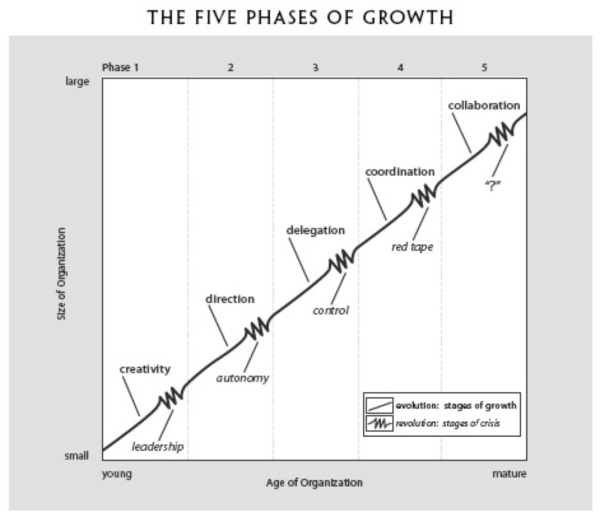Dear SEA Member - May 24, 2013
BECOMING A LEADER Part 1
Much has been written on the subject of leadership. This paper addresses the evolution of small company leadership and proposes a roadmap of sorts for identification of where you are and where you’re going as a leader.
Early Stages of Small Business
You’re the “doer” and the prime mover of the business. You probably had or learned the skills growing up. Some of you may have learned machining from your father. You’re most likely an expert even if it was just your idea (“creativity”) and you invested many years of “sweat equity” building the business.
In this stage most likely a lot of your time goes into creative activities and solving problems. In his 1972 Harvard Business Review article, Larry Greiner proposed the model below.

His study proposed that in the early stages almost all activities were collaborative, creative, and very little time was available for management. There might even be a disdain for management activities. But eventually the need for leadership would emerge calling for an evolution to having someone “in charge.”
Each stage results from a “crisis” – the words on top are how the company evolved, and at the limit of that evolution, a new “crisis” presents itself as a strong need that is solved by the next evolution. In our case we are at the bottom right – we have evolved through hard work and creativity, and now the organization is successful and requires leadership to evolve to the next level. Leadership provides more direction and the organization grows and evolves until the need for autonomy becomes a crisis born by a leader who has become too strong, too directing, to demanding, too constraining, and a limit on continued growth. And the cycle continues. But let’s go back to the beginning and start there.
If the business is successful then you begin to get into the fringes of managing – things such as hiring, coaching employees, training, and more. But nevertheless in this stage you continue to work shoulder to shoulder with everyone and you feel less comfortable sitting in an office doing “management” duties (whatever that is).
Success Leads to Growth – Someone Needs to Manage
Why does someone need to manage anyway? We’re all adults. Can’t everyone just figure it out? But things start to surface.
People need direction.
Hiring – we need more people and someone needs to make sure we get the right ones. This is often the first management task that we experience. I remember my first hiring experience as a new manager. It wasn’t until I got into the room and sat down that I realized I had no idea what to do. At that point my goal became, “Get through this interview.” I suspect that I did more talking than listening. And as a result, most of our experience in this early stage of management is bad hiring – people who don’t fit, or become a problem later on. It becomes apparent that more attention and effort needs to go into hiring.
That realization is often followed with a series of quick fixes. Make a list of questions. Get more people to interview them. Make sure you check their references better. It’s not until later that you realize that repeating a lot of poor interviews just makes it more likely you’ll hire the wrong person. Not to mention we usually follow-up poor hiring practices with poor training practices. We put the new person with the old person.
Managing People – the next thing that usually surfaces that needs management is people. It turns out if you put a bunch of people on machines with plenty of work to do, they don’t necessarily work productively. Things happen. Mary doesn’t like Jim and is trying to make him look bad. John does like the work he’s doing and is looking for something else. Fred and Jerry are spending a lot of time in the break room or hiding out in the restroom.
High performance is not a natural act.
It takes a good manager to set clear goals for people, instruct them on behaviors that are out of bounds, provide for motivation when they’re doing things right, and to keep one bad apple from spoiling the whole bunch. Adults aren’t automatically good coaches – just go to your son’s soccer game and you’ll see that it takes a lot of hard work and study to become a good coach. More people means more needs for management. Eventually the demands of the business require you to manage and not just do.
Managing Customer Issues – at some point the customers are so large that making a mistake can be disastrous so you need to spend more time backing up your sales force – assuming you have one. Some customer problems demand management attention. They want to visit and tour your facility. They want to meet the “big guy” and you’re in a command performance.
Continued on Part 2 |

Michael Beason
Chairman, CEO
Supplier Excellence Alliance |
ARCHIVE OF PAST REPORTS
Process Maturity for Leaders
February 26, 2013
Collaboration
November 3, 2012
Improving Your Supply Chain
October 23, 2012
What does it take to compete and win business in today’s aerospace
and defense supply chain?
April 25, 2012
Chairman's Message
January 25, 2012
Aerospace and Defense Outlook
September 23, 2011
Why Get Certified Anyway?
April 8, 2011
Documenting Your Roadmap Processes Will Not Improve Your Operations
September 20, 2010
The Power of Branding
May 24, 2010
Where Process Improvement Goes Wrong
March 19, 2010
Perfect Performance
March 10, 2010 |


